August 2020 : To the Scilly Isles and back
LaterEarlier |
Our original plan for this year’s sailing had been to head out of Bristol and meander our way via Wales and Ireland to Scotland, finally leaving Aremiti in Oban for the winter. But the pandemic put paid to that. However, as a matter of pure luck, Aremiti has been berthed in Bristol over last winter - for the first time in many years – and was therefore available for the perfect socially distanced holiday. Initially all harbours and marinas were closed, but once things started opening up, we decided on a mini-cruise to the Scillies – which was one of the highlights of last year’s travels. We hadn’t expected to return there, but were more than happy to take the opportunity to go back. However, what we thought was going to be a gentle outing didn’t go quite to plan, as we packed in enough experiences – good and bad – as we might have had over a whole summer. It’s a long way to the Scillies from Bristol – about 190 miles each way with
very few ports of refuge, and we decided to take it easy, not having any
particular timescale. By the time we were ready to leave the forecast was
near perfect for the trip down – that is to say very little wind -
infinitely preferable to the prevailing south-westerly on the nose all the
way. We left our berth in Bristol marina at 7am on 5 August – on a spring
tide. Bristol locks are opened for just two hours before high water and our
departure was slightly complicated by the fact that the timing of high water
co-incided not only with the time of the embargo on bridge openings during
the morning rush hour, but also the fact that this was a ‘stopgate’ tide –
when the water level in the river rises higher than the water in the
harbour, requiring junction lock to be closed until the water level falls. Sailing in the Bristol Channel is all about the tides. So the following morning we departed on the 10.30 lock to pick up a full outgoing tide for the first leg of the trip. There was no wind and in mist and drizzle not much to see – but sluicing between the Holms at 10.9 knots was very satisfying! We could just about make out the vast construction site of Hinkley Point Power station as we headed towards Porlock Bay arriving mid afternoon to anchor and wait out the adverse tide. 38 miles in 5 hours. Rather than rushing off on the next ebb for a night sail, we stayed put until the following morning which dawned hot, sunny - and windless. The next leg was 76 miles down to Padstow and a major objective, We enjoyed a reasonable night’s sleep – the buoy lost interest in us after a bit, giving us a quieter time. The fog had gone in the morning, but still no wind as we got away just after 6.30 for the final leg of 62 miles to the Scillies. All was going perfectly until about the halfway point, towards the tip of Cornwall off Pendeen Lighthouse on a very unforgiving coast, when the engine started making strange noises and then lost all power. Luckily the sea state was very calm, though it did look as if the fog might be returning. Without any wind we drifted gently as Chris first checked the engine which appeared OK, then the prop which seemed clear. On checking the fuel filter he found that fuel wasn’t flowing from the tank. We always leave the tank full over winter and the gauge showed full when we left. To make a physical check Chris removed the filler cap - and found that the tube leading into the tank had delaminated and was dropping debris into the fuel, presumably causing the blockage. We realised that even if we could get the engine started again the same thing was likely to happen. There was nothing we could do about it there but no wind to get anywhere else. There seemed no other option but to call the coastguard – our first time ever. The Sennen lifeboat was already out rescuing canoeists, so the St Ives lifeboat was called. As the problem could potentially mean taking out the fuel tank – a very major structural job, we mentioned that ideally we needed to get to Newlyn, but were told we would be taken to ‘the nearest safe haven’ likely to be St Ives. This surfing beach didn’t sound like much of a safe haven but we weren’t in a position to argue. The lifeboat duly arrived and with very little discussion, we were hooked up for
the 3 hour tow back the way we had come, to St Ives. Given insufficient wind to sail to anywhere else, we narrowed down 3 options:
Through Penzance harbour we were put in touch with a workboat tug skipper who was prepared to set off for us immediately. Interestingly we encountered the coxswain of the lifeboat on the quay before we set off. He was somewhat mortified that he had not entirely understood the situation and said that had he realised the nature of the repairs required, he would not have regarded St Ives as a safe haven - anchored on a lee shore with forecast worsening conditions, but would have had us taken to Newlyn. Our second tow, all around the tip of Cornwall went without incident and was almost relaxing in a weird sort of way as we passed the familiar landmarks – the mine workings, Long Ships, Lands End, Lamorna Cove, Mousehole …. The skipper was supremely professional and deposited us in Penzance harbour right below the engineering workshops with utmost delicacy and skill. Over the next couple of days the fuel tank was drained and examined with the use of an endoscope and debris removed and the primary filter unit replaced. We left Penzance in thick fog, but this soon cleared as we set out again for the
Scillies and the passage was without incident. We were still without any
wind, so the 34 mile passage provided a good test for the fuel system. Down in the far south west, we didn’t experience the extreme weather we heard about on news of the rest of the UK - heatwaves, thunderstorms and torrential rain. Our weather was very calm, pleasantly warm and sunny with just the two foggy patches. It wasn’t a long visit, but so delightful and relaxing it felt quite timeless…. However, having noted a large fleet of yachts on Marine Traffic leaving the Scillies the previous day and with forecasts of an approaching storm, it seemed prudent to head back to the mainland. Infuriatingly, given the amount of wind on its way, we had very little for the 12 hour/67 mile passage, and arrived into Padstow harbour at 1730 – into the thick of the tourist mayhem.
We were feeling very pleased with ourselves as we approached Porlock, although
the wind had dropped and we were motoring along the north Devon coast in
darkness. Then just after midnight, with under 2 miles to go, the engine
stopped. Déjà vu! There was just enough of an offshore breeze to sail into
the bay to anchor. Although the holding there isn’t very reliable, the
anchor held and we were safe. This was quite a blow to put it mildly! After
the many hours of motoring around the windless Scillies and the passage to
Padstow, we had regained our trust that all was well. However a check
revealed the same problem as last time – a blockage in the fuel line. Chris
was able to clear this and change the filter, whereupon the engine started
up as if nothing had happened. However, we didn’t feel it was prudent, with an engine that might cut out at any time, to set off across to Avonmouth and up the Avon into Bristol. The passage is only a couple of hours, but if both wind and engine failed half-way up the river we’d be in serious difficulties in such tidal waters. So before making this final short leg, Chris fitted a back-up fuel tank which we could switch to immediately in the event of another blockage from the main tank. We were all set to go until - a final sting in the tail - Junction Bridge in Bristol – one of the two that have to be swung for yachts to enter the harbour – broke down. It has now been repaired and we enjoyed a perfect passage up the river to take Aremiti back to her berth in Bristol Marina – after her trip of 444 nautical miles. Following these experiences it is apparent that the fuel system, put in with the new engine seven years ago, and which has performed flawlessly since then, was not fitted with the pipes of the correct standard. These have now been replaced, but the tank itself needs further inspection to ensure that there is no more debris to block the system. Something to look forward to over the winter! |
 We therefore exited through junction lock and bridge first and then waited
in Cumberland Basin for an hour and a half until the bridge embargo ended,
by which time the lock into the river was on free flow. It was a peaceful
sunny morning and chugging down the River Avon is always a lovely trip – and
it was wonderful to be escaping! Emerging into the Severn at Avonmouth, we
popped across to Portishead marina, gradually acclimatising ourselves to
being back on board the boat – and giving Chris the opportunity to don wet
suit and check the state of the hull and clean the prop – as we haven’t had
the boat out of the water this year.
We therefore exited through junction lock and bridge first and then waited
in Cumberland Basin for an hour and a half until the bridge embargo ended,
by which time the lock into the river was on free flow. It was a peaceful
sunny morning and chugging down the River Avon is always a lovely trip – and
it was wonderful to be escaping! Emerging into the Severn at Avonmouth, we
popped across to Portishead marina, gradually acclimatising ourselves to
being back on board the boat – and giving Chris the opportunity to don wet
suit and check the state of the hull and clean the prop – as we haven’t had
the boat out of the water this year.
 halfway through
the passage, was to arrive at the pinch point between Hartland Point and the
island of Lundy where the tide runs at its strongest, before it turned
against us.We left a couple of hours before high water hoping to pick up
some counter current inshore and enjoyed a good run in hot sunshine arriving
at the Point at just the right time. At this point the Bristol Channel
widens out and the tidal currents are weaker, so progress, though slowed was
not too dreadful through the adverse tide. However, with about 3 hours to go
a dense fog descended – not fun in lobster pot infested waters. We finally
arrived, after dark, into the little cove by the Padstow Lifeboat Station
inside Trevose Head where we have rested on previous occasions. 76 miles in
12 hours. We tied up to one of the four buoys bouncing around there – not
entirely relaxing as its enormously high mooring ring seemed intent on
taking out the bow navlights, with a confusion of wind and tide bashing us
into it.
halfway through
the passage, was to arrive at the pinch point between Hartland Point and the
island of Lundy where the tide runs at its strongest, before it turned
against us.We left a couple of hours before high water hoping to pick up
some counter current inshore and enjoyed a good run in hot sunshine arriving
at the Point at just the right time. At this point the Bristol Channel
widens out and the tidal currents are weaker, so progress, though slowed was
not too dreadful through the adverse tide. However, with about 3 hours to go
a dense fog descended – not fun in lobster pot infested waters. We finally
arrived, after dark, into the little cove by the Padstow Lifeboat Station
inside Trevose Head where we have rested on previous occasions. 76 miles in
12 hours. We tied up to one of the four buoys bouncing around there – not
entirely relaxing as its enormously high mooring ring seemed intent on
taking out the bow navlights, with a confusion of wind and tide bashing us
into it. 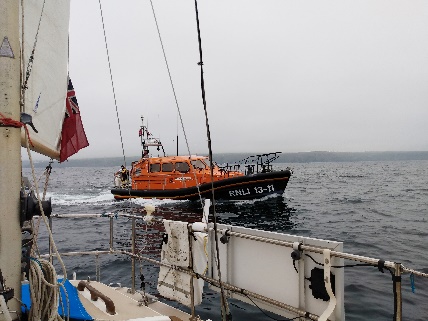 All very professional
and a very smooth trip – a friendly bunch of guys. They gently deposited us
at anchor some distance off the beach promising to put us in touch with an
engineer. All very depressing and ignominious. That evening a swell started
rolling in and we rolled abominably all night feeling very conscious that
should conditions worsen we couldn’t instantly move ourselves off this lee
shore. An engineer turned up the next morning, but within about half an
hour, without having carried out any diagnosis, he and his sidekick were so
seasick they declared that we should all be ‘pulled off’ the boat. As we
couldn’t progress the situation any further from the boat, we went ashore to
investigate available options – leaving poor Aremiti pitching and rolling
violently on her own. Ashore – where the holiday scene was in full, carefree
and not very socially distanced swing - the locals were very pessimistic –
conditions were only going to get worse and last most of the week, several
yachts have dragged on to this beach, no one would be prepared to tow us
anywhere, etc. etc. The role of local knowledge in this sort of situation is
a mixed blessing. It would seem stupid to ignore advice about somewhere
you’ve never been before – but locals may have a tendency to exaggerate the
perils of their patch.
All very professional
and a very smooth trip – a friendly bunch of guys. They gently deposited us
at anchor some distance off the beach promising to put us in touch with an
engineer. All very depressing and ignominious. That evening a swell started
rolling in and we rolled abominably all night feeling very conscious that
should conditions worsen we couldn’t instantly move ourselves off this lee
shore. An engineer turned up the next morning, but within about half an
hour, without having carried out any diagnosis, he and his sidekick were so
seasick they declared that we should all be ‘pulled off’ the boat. As we
couldn’t progress the situation any further from the boat, we went ashore to
investigate available options – leaving poor Aremiti pitching and rolling
violently on her own. Ashore – where the holiday scene was in full, carefree
and not very socially distanced swing - the locals were very pessimistic –
conditions were only going to get worse and last most of the week, several
yachts have dragged on to this beach, no one would be prepared to tow us
anywhere, etc. etc. The role of local knowledge in this sort of situation is
a mixed blessing. It would seem stupid to ignore advice about somewhere
you’ve never been before – but locals may have a tendency to exaggerate the
perils of their patch. 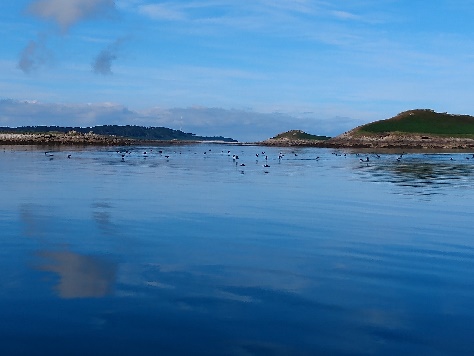 We
anchored in the Eastern Isles off Great Ganilly – very happy and relieved.
The following day was everything we had hoped for in the Scillies – hot
under a clear blue sky and completely calm. Magical – we stayed put,
relishing our surroundings, watching seals popping their heads above water
and birds flying low. We enjoyed the same conditions the following day,
moving round through the rock-strewn passage of 4 miles to St Helen’s Pool
to the northwest of the archipelago – another idyllic spot. Planning
passages in the Scillies always takes longer than actually doing them! Going
ashore on St Helen’s island we were intrigued to find a ruined Quarantine
Station dating from 1764. However, it wasn’t in operation! The following day
we moved cautiously between the rocks to take a buoy off the harbour of Old
Grimsby on Tresco. After a wander around the very tasteful environs of
Tresco, we treated ourselves to a meal out at the ‘Ruin Cafe’ – very beachy,
very expensive, very delicious.
We
anchored in the Eastern Isles off Great Ganilly – very happy and relieved.
The following day was everything we had hoped for in the Scillies – hot
under a clear blue sky and completely calm. Magical – we stayed put,
relishing our surroundings, watching seals popping their heads above water
and birds flying low. We enjoyed the same conditions the following day,
moving round through the rock-strewn passage of 4 miles to St Helen’s Pool
to the northwest of the archipelago – another idyllic spot. Planning
passages in the Scillies always takes longer than actually doing them! Going
ashore on St Helen’s island we were intrigued to find a ruined Quarantine
Station dating from 1764. However, it wasn’t in operation! The following day
we moved cautiously between the rocks to take a buoy off the harbour of Old
Grimsby on Tresco. After a wander around the very tasteful environs of
Tresco, we treated ourselves to a meal out at the ‘Ruin Cafe’ – very beachy,
very expensive, very delicious. 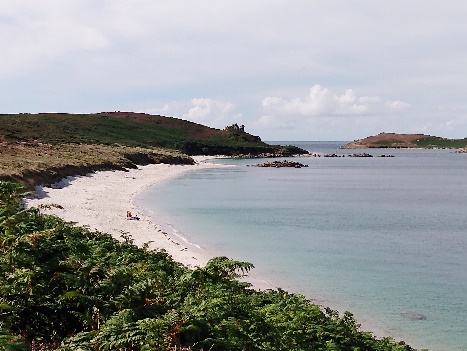 Next we moved north-westwards again to the
outside of the islands and around to the north to anchor off the beach on
the north side of the island of St Martin’s. With a brilliant white sandy
bay stretching away and turquoise water we could have been in the Caribbean!
The weather was also quite Caribbean for our walk around the eastern part of
St Martin’s – first to ‘Higher Town’ – actually a rather small village - and
then on to the daymark at the eastern tip of the island – an iconic spot
visible throughout the Scillies. It was a perfect final day.
Next we moved north-westwards again to the
outside of the islands and around to the north to anchor off the beach on
the north side of the island of St Martin’s. With a brilliant white sandy
bay stretching away and turquoise water we could have been in the Caribbean!
The weather was also quite Caribbean for our walk around the eastern part of
St Martin’s – first to ‘Higher Town’ – actually a rather small village - and
then on to the daymark at the eastern tip of the island – an iconic spot
visible throughout the Scillies. It was a perfect final day.  We enjoyed an excellent week in Padstow with the boat in ‘holiday cottage’ mode.
We’re used to living aboard all summer and weren’t in any rush to get home –
and what’s not to love about spectacular coastal walks and guzzling on
pasties, fish and chips and cream teas – not to mention a visit to Rick
Stein’s Seafood Restaurant. The town was jam packed with carefree (pandemic
– what pandemic?) holiday makers – much as it usually is. We were very
happy, chilling on the pontoon in the middle of the harbour nicely socially
distanced from the hubbub. We waited out the two storms – Ellen and Francis
– experiencing some gusty weather and showers but nothing of the devastation
reported by friends and on the news.
We enjoyed an excellent week in Padstow with the boat in ‘holiday cottage’ mode.
We’re used to living aboard all summer and weren’t in any rush to get home –
and what’s not to love about spectacular coastal walks and guzzling on
pasties, fish and chips and cream teas – not to mention a visit to Rick
Stein’s Seafood Restaurant. The town was jam packed with carefree (pandemic
– what pandemic?) holiday makers – much as it usually is. We were very
happy, chilling on the pontoon in the middle of the harbour nicely socially
distanced from the hubbub. We waited out the two storms – Ellen and Francis
– experiencing some gusty weather and showers but nothing of the devastation
reported by friends and on the news. 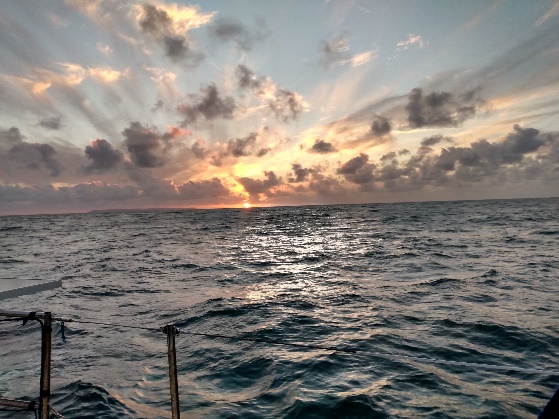 However, all good things come to an end and after a week decided it was time to
leave. We set off on the tail of Storm Francis - on a sunny breezy sunny day
with wind and waves exhilaratingly on the port quarter, actually able to
sail for a change! This next leg back to Bristol was the 76 mile passage up
to Porlock Bay where we planned to anchor for 6 hours of adverse tide before
continuing on. We passed the milestone of Hartland Point – where the water
turns brown – after about 7 hours, and were treated to a spectacular sunset
over Lundy.
However, all good things come to an end and after a week decided it was time to
leave. We set off on the tail of Storm Francis - on a sunny breezy sunny day
with wind and waves exhilaratingly on the port quarter, actually able to
sail for a change! This next leg back to Bristol was the 76 mile passage up
to Porlock Bay where we planned to anchor for 6 hours of adverse tide before
continuing on. We passed the milestone of Hartland Point – where the water
turns brown – after about 7 hours, and were treated to a spectacular sunset
over Lundy. 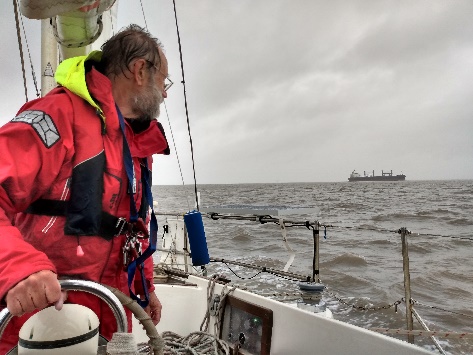 This gave us a better night’s sleep than we
might otherwise have had but left us with the problem that the fault could
recur at any time. It looked as though there would be enough wind to sail
the 38 miles to Portishead, so after about 5 hours we set off again on a
good tide. The passage went very well – sailing virtually all the way – much
of it in drenching rain. We used the engine twice - without incident - first
to ensure the tide didn’t sweep us into the path of a large ship approaching
Avonmouth and then for the final few miles into Portishead marina where they
were able to accommodate us over an exceptionally busy bank holiday weekend.
This gave us a better night’s sleep than we
might otherwise have had but left us with the problem that the fault could
recur at any time. It looked as though there would be enough wind to sail
the 38 miles to Portishead, so after about 5 hours we set off again on a
good tide. The passage went very well – sailing virtually all the way – much
of it in drenching rain. We used the engine twice - without incident - first
to ensure the tide didn’t sweep us into the path of a large ship approaching
Avonmouth and then for the final few miles into Portishead marina where they
were able to accommodate us over an exceptionally busy bank holiday weekend.